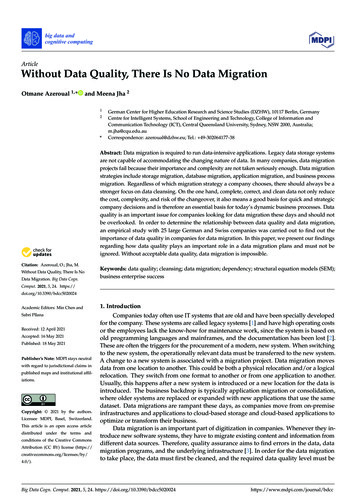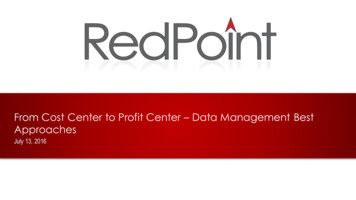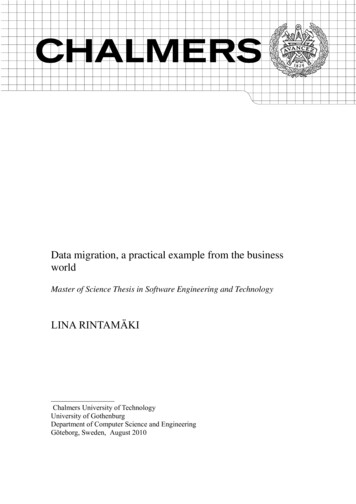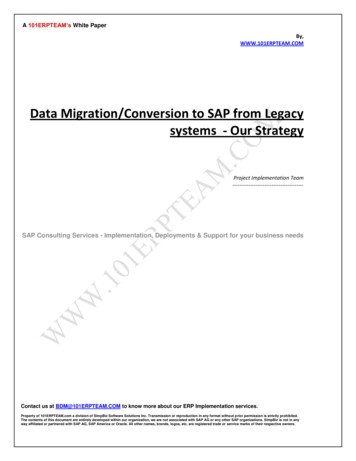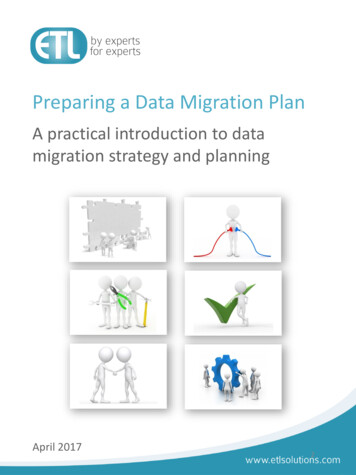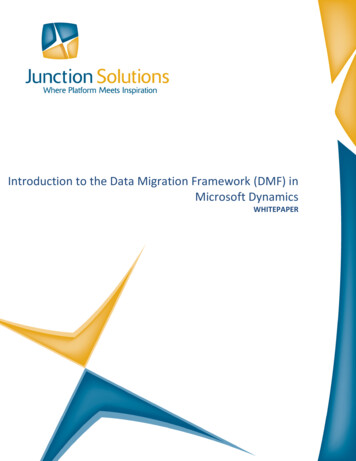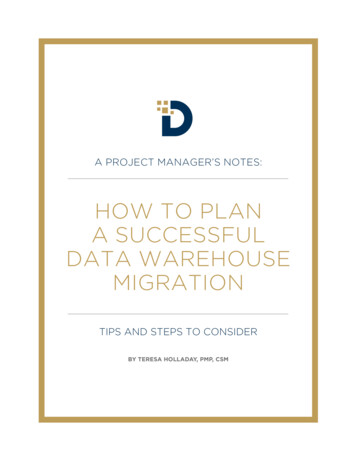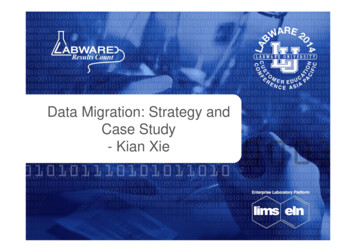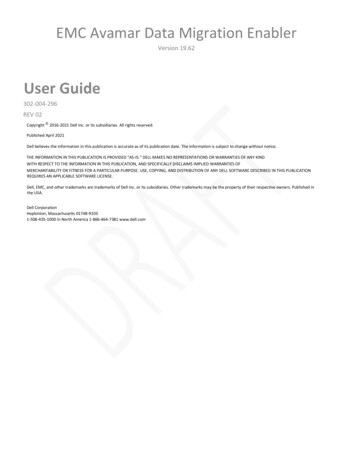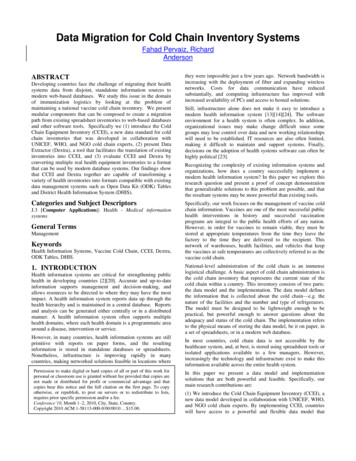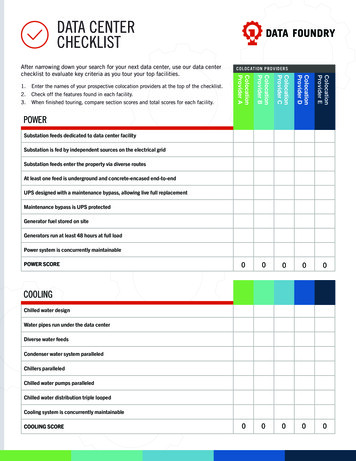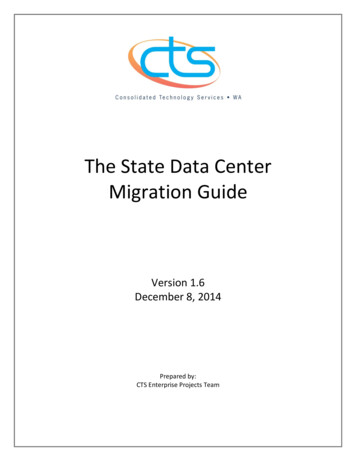
Transcription
The State Data CenterMigration GuideVersion 1.6December 8, 2014Prepared by:CTS Enterprise Projects Team
ContentsDOCUMENT REVISION HISTORY . 3INTRODUCTION . 5PURPOSE OF THIS GUIDE . 6DOCUMENT STRUCTURE . 6ASSUMPTIONS . 7STATE DATA CENTER MIGRATION TASKS . 7APPENDIX A – REFERENCED DOCUMENTS . 22APPENDIX B – MIGRATION CHECKLIST . 23REFERENCES. 252
Document Revision HistoryDescription of ChangeFirst version (1.0)Minor Revisions (1.1)- Added Service Desk email address- Updated titles of Network Models B & C- Updated SLA step to reference to “Terms ofService”. Also changed “update” to “create”.- Corrected “IA” to “IAA”- Added “(optional)” on step 25 and indicated thisstep applies to Customers using the move vendor- Added new step for end of migration notification- Added “Terms of Service” to SLA step in checklist- Added signature rowsMinor Revisions (1.2)- Corrected form titles for facilities documents andadded Network Questionnaire - Part 2 forcustomers selecting Network Model B, C or D- Corrected form title for facilities document- Corrected form title for facilities document- Corrected form title for facilities document- Corrected form titles for facilities documents andadded network questionnaireMinor Revision (1.3)- Split Colocation On-boarding Form task from IssueQuote and moved earlier in the process- Added step for “Complete Elevations”Minor Revision (1.4)- Moved “Schedule Regular Status Sessions” to occurafter the High Level Consult- Moved Connectivity Cut Sheet requirement to #16- Added SDC High Level Migration Strategy Form to#9 High Level Strategy- Added Security Review Disposition form to step for“Combined High Level Consult”- Added new step to “Begin Elevation Planning”- Redefined process for #18 Create the DetailedDesign and Bill Of Materials- Redefined process for #22 Complete Elevations- Added Authorized Approver form and updated theprocess for “Complete SDC Facility AccessRequirements”.- Appendix B – Migration Checklist. Moved ScheduleRegular Migration Status Session(s) from step 9 toStep 12 to match step in guide.3PageAllDate Nya14154/294/29NyaNya216/3Doug
Description of ChangeMinor Revision (1.5)- Added reference to FAQ and added FAQ link.- Added link to the list of CTS Customer AccountManagers.- Added reference to WA-Notification emaildistribution list.- Changed text of “MP2 Service Desk RequestTemplate (Word)” to “MP2 Service Desk RequestTicket (Word)”.- Added a link to “Network Questionnaire Part 2”.- Changed text of “Customer On-boarding Form(Word)” to “Colocation On-boarding Form (Word)”.- Removed reference to the move vendor at HighLevel Consult (HLC) Meeting. Consult with movevendor comes in a later step.- Replaced reference to “SLA” with reference to“TOS” and moved to occur after acceptance ofthe quote.- Updated reference and link to the “CTS DataCenter Facilities Equipment Tracking Log”.- Changed text of “CTS Service Desk Ticket” to“Physical Migration Service Desk Requesttemplate (Word)”.- Rephrased step regarding “Prepare Facilities” tobe more clear.- Added detail regarding process performed byCTS’ Network Control Center (NCC).- Inserted new step to Discontinue OB2 A la Cartebilling.- Modified all document links to contain direct linksto the documents instead of the folder.- Restructured referenced document list to reflectorder of appearance in this document. Addedlinks to new documents referenced in thisversion. Added link to main ASK SDC Projects AllGeneral folder.- Minor spelling and grammar corrections.Minor Revision (1.6)- Added the need for a final prep meeting fivebusiness days before a migration event.- Clarified the steps associated with migrationnotifications to indicate both CTS and theCustomer provide notifications.- Updated the step for Customer Acceptance toinclude notification from Customer to CTS.4PageDate idi1811/10Doug2011/10Doug5 - 2/8Heidi18-2012/8Heidi2012/8Heidi
IntroductionSince the 1960s the state of Washington has grown its information technology infrastructure in supportof state business operations. Over this span of time, many data centers were opened across ThurstonCounty. During the 2009 legislative session ESHB 1216 (PDF) gave DIS the authority to “lease develop orlease purchase a state data center and an office building,” with the intent to begin consolidations. OnJuly 15, 2011 construction of a new State Data Center was completed. Consolidated Technology Services(CTS) began moving into the adjoined office building and took possession of the State Data Center (SDC)building. In July 2013 the OCIO published the State Data Center (SDC) Plan Update (PDF) outlining astrategy to migrate 100% of computing hardware in OB2 to the SDC and to develop a plan for migratingthe remaining Thurston County data centers.Consolidation of data centers is not unique to the state of Washington. Some of the key businessconsiderations that typically drive data center migrations include:1. Multiple regional data centers lack standardization, efficiencies and capacity for growth andare unable to meet end-to-end service level objectives. (Chawla, 2011)2. Trends for data center growth are rising at compounding rates. Server workloads anddensities are projected to increase by 10% year-over-year. Network bandwidth capacitydemands are expected to grow by 35% , storage capacity growth by 50% and power costsare expected to increase by 20%, year-over-year. (Gartner, 2014)3. Existing data center has obsolete infrastructure in terms of high power consumption, spacetaxing, unsupported equipment with poor availability/performance which does notintegrate well with modern applications and technologies.4. Current data center floor space is nearly 100% utilized, needs optimization to enable growthcapabilities.5. Regulatory requirements drive a need for relocation or redundancy.Data center migrations are highly strategic projects that must be executed without impacting businessoperations, service levels, or data protection requirements.Each customer environment is unique and will have its own challenges. One detailed migration strategywill not fit every environment. However, every solid migration strategy should aim for a near-zerodisruption of business services. This objective drives the need to understand all the major subsystems ofa data center which include: Nature and criticality of the applications that cater to different business servicesServers, shared hosting environments, and databases that host the applications or business logicDisk storage for storing data and the frequency of accessNetworks that provide the access to the dataNetwork security that protects the business dataPhysical security of the environmentPerformance and service level agreements5
Purpose of this GuideThe purpose of this Migration Guide is to define the steps that Consolidated Technology Services (CTS)and Customers will take to complete readiness tasks necessary for the migration of systems into theSDC. It also contains the migration and post migration tasks needed to fully complete the migrationeffort.Each Customer migrating systems into the SDC is asked to identify an Agency ImplementationCoordinator (AIC) to serve as the primary Customer contact. While the AIC is not expected to be anexpert in all areas, the AIC is responsible for coordinating the activities identified as Customerresponsibility.The activities are summarized in a checklist that will be used to track progress and when completesignifies readiness for migration scheduling. Completion of these activities is critical to migration successand will help to minimize any unplanned service disruption. When all readiness tasks are complete, theAIC will submit the completed checklist to the CTS Client Liaison. The CTS team will review and either a)confirm readiness or b) return the checklist for further work. After readiness is confirmed, migrationwork and related activities will begin as scheduled.Throughout the migrations, CTS will need to manage many independent, yet concurrent, activities.These will need to be coordinated to look for interdependencies, conflicts, and ensure resourceavailability. A Migration Calendar (Web) has been published reflecting SDC migration activity to assistwith looking for overlaps and/or available windows. This calendar is accessible for Customers withaccess to the State Government Network (SGN). An FAQ (Web) and other materials covering themigration to SDC can be found at here (Web).Document StructureAs agencies progress through the Guide, they will see prerequisite tasks that: Must be completed internally by the Customer agency Must be completed by CTS staff Must be completed in coordination with CTSEach task is prefaced with a table entry that identifies the primary party responsible for completing thework activity, the task number, and the task description. The table below provides a brief sample:Party#Task DescriptionBoth1Initiate Migration PlanningEach table entry will be followed by a more detailed description of the work to be accomplished for thattask. Migration tasks have been organized in a general chronological order.Note: All migration tasks have been built to include a wide range of scenarios and not all tasks apply toevery migration. These tasks will be clarified with the appropriate parties during the planning phase.6
AssumptionsThis Guide makes the following assumptions:1. CTS has: readied the facilitiesinstalled equipment enclosuresinstalled backbone and structured cabling outside the enclosuresprepared the network corepublished colocation service information2. The Customer will avoid (as much as possible) the transformation of existing systems to a newtechnology base. Simplifying migrations helps to ensure the objectives and timeframes ofmigration schedules can be met. Reducing transformation is desirable to ensure that systemsthat were operational prior to migration remain so afterward. If issues arise after migration isperformed, it is much easier and effective to troubleshoot against known, workingconfigurations. Configuration freezes should be discussed as part of preparations.State Data Center Migration TasksBased on CTS’ experience migrating systems and services into the SDC, key activities have beenidentified and fall into these broad categories: Identify business requirementsAnalyze and design infrastructure and applicationIdentify migration options and planBuild infrastructure and roll-out applicationsVerify applicationsDecommission source data center infrastructureThe equipment being moved into the SDC is a combination of equipment managed by CTS andequipment owned and managed by Customers. Many of the tasks performed to support the migrationswill be performed by the Customer in collaboration with CTS.60-120 DAYS BEFORE MIGRATIONBoth1Initiate Migration PlanningDiscussions regarding migration to the SDC are likely to evolve from a variety of circumstances.Customers who express interest to CTS staff will be asked to contact the Service Desk to initiate formalplanning. If CTS has not heard from a Customer that needs to migrate into the SDC (such as a customerin the existing aging state data center), CTS will contact the Customer to initiate planning.7
Both2Open a Service Request TicketTo initiate planning, the Customer or the CTS Client Liaison will submit the MP2 Service Desk RequestTicket (Word) to servicedesk@cts.wa.gov. The resulting ticket created by the CTS Service Desk will beused as the ‘Parent’ ticket to track the entire migration process. The Infra Request Number will be givento the Customer agency.The ‘Parent’ ticket will be used to capture information such as Customer contact information, adescription of the inquiry (i.e. ready to migrate to SDC), the timeframe of the desired migration, and theCustomer’s basic constraints for migration.Support work request tickets (aka ‘Child’ tickets) will be affixed throughout the migration process asrequired by the change management processes followed by the CTS technical teams supporting themigrations.Customer3Identify Move Team and Customer Contact(s)All Customer data will be updated and archived in Customer folders on the SDC Projects page of the CTSAgency Shared Knowledge (ASK) SharePoint site.The Customer AIC will identify the staff resources needed for migration activities and populate eachmove team member’s AD account into the associated distribution list (i.e. CTS DL SDC Project
State Data Center Migration Tasks ased on TS’ experience m igrating systems and services into the SDC, key activities have been identified and fall into these broad categories: Identify business requirements Analyze and design infrastructure and application Identify migration options and plan

